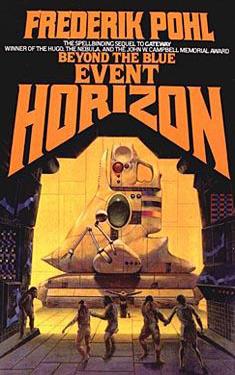Outside the Norm: Announcing the Outside the Norm Reading Group
Rhonda Knight is an Associate Professor of English at Coker College in Hartsville, SC. She teaches Medieval and Renaissance literature as well as composition courses. When she looked over last year’s reading list, she was shocked to see that only 17% of the authors she read were women. This blog will record her attempts to read authors that are generally considered out of the science fiction norm: women, persons of color, and non-U.S. and non-U.K. authors.
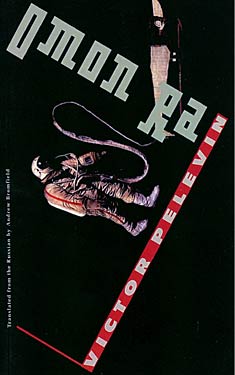 Over in the forum, several of us have been putting together an Outside the Norm Reading Group for the remainder of the year and continuing into the next. It will function much like a book club. We will read one book a month and will spend at least the first week of the following month discussing the book in the group. Emil has offered this format for discussion:
Over in the forum, several of us have been putting together an Outside the Norm Reading Group for the remainder of the year and continuing into the next. It will function much like a book club. We will read one book a month and will spend at least the first week of the following month discussing the book in the group. Emil has offered this format for discussion:
- Initial impression of the book
- Themes
- Particular theme that impressed
- Favorite scene/moment, etc.
We have planned books through next January, but we would love for this to continue longer and get your input for future books. We envision this as a fluid "book club" and hope that people will be able to join (and leave) according to their interest in the books we will discuss each month.
The July book is Victor Pelevin’s Omon Ra. We will discuss it during the first week of August. It is only 153 pages, so it will be easy to catch up this month.
The remaining schedule is:
- August: Ben Okri, The Famished Road
- September: José Saramago, Blindness
- October: Mikhail Bulgakov, The Master and Margarita
- November: Angela Carter, Nights at the Circus
- December: Yevgeny Zamyatin, We
- January: Doris Lessing, Memoirs of a Survivor
Remember: We will discuss each book during the first week of the following month.
Feel free to offer up suggestions of science fiction, fantasy and horror books that you feel are "outside the norm," which we have been defining as books by women, persons of color, or non-US/UK authors. We have been using the Guardian list as a guide, but we certainly not limited to those books.
Please join us in the forum!
GMRC Review: Beyond the Blue Event Horizon by Frederik Pohl
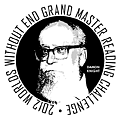 Guest Blogger and WWEnd member, valashain, reviews science fiction and fantasy books on his blog Val’s Random Comments which we featured in a previous post: Five SF/F Book Blogs Worth Reading. Val has posted many great reviews to WWEnd and this is his seventh for the GMRC. Be sure to visit his site and let him know you found him here.
Guest Blogger and WWEnd member, valashain, reviews science fiction and fantasy books on his blog Val’s Random Comments which we featured in a previous post: Five SF/F Book Blogs Worth Reading. Val has posted many great reviews to WWEnd and this is his seventh for the GMRC. Be sure to visit his site and let him know you found him here.
Beyond the Blue Event Horizon is the second book in Frederik Pohl‘s Heechee Saga, a series that started out with the 1972 novella The Merchants of Venus. This novella was reprinted in Platinum Pohl among other collections. The first Heechee novel, Gateway (1976), is one of his best regarded solo novels and won him a whole shelf full of awards. I guess it is not surprising that after that kind of success, a sequel has a hard time living up to expectations. I’ve heard a lot of people say this is one of those series you should only read the first book of. Pohl went on to write three more books and a bunch of short fiction, none of which I have read, but personally I didn’t think Beyond the Blue Event Horizon a bad book. It is very different from Gateway though, that has to be said.
After successfully facing his successes and failures at Gateway, Robinette Broadhead is now living the life of a very rich man. He has married and has diverse interests in various profitable businesses as well as close ties with the Gateway corporation and even quite a bit of political influence. In other words, he has it made. Still, there is the nagging feeling of guilt that the woman who is the love of his life is stuck in a singularity. In business problems arise as well when an expedition to a distant Heechee installation, which Robinette hopes will help combat the chronic food shortages on Earth, meets with unexpected problems. It takes 25 days for instructions to reach the explorers, and as the situation in the outer solar system gets more and more out of control, Robinette’s problems increase. Desperate action is needed.
One of the most striking differences between Gateway and Beyond the Blue Event Horizon is that Pohl employs a lot of different points of view in the second volume. In fact. Robinette doesn’t even show up until the fourth chapter, some 50 pages into the novel. A lot of the major players in the novel get a point of view, as well as some of the machine entities, but there are quite a few of them, so we only get to scratch the surface of most of these characters. Where Pohl was very concerned with the psychology of Robinette in the first novel, the plot is obviously more important in the second. That is not to say that Robinette’s internal struggle is not an important part of the story, he is still this petty, selfish but basically decent person we met in Gateway, but Pohl leans quite heavily on events in the previous novel to convey this to the reader.
The Heechee on the other hand, although still very absent, are much more important to the story. The artifact being explored is clearly one of theirs but has been circling the sun since before humanity’s ancestors learnt to use tools. It has a history of its own and that history includes other intelligences as well. Pohl reveals that history through these many points of view, gradually revealing a new part of the mystery with each chapter. It is this revealing that may put off some readers. In Gateway, the Heechee are a mystery. With only their incomprehensible artifacts and structures around, very little was actually known for sure about them. It made the story unpredictable in a way. With a Heechee artifact around, you never know what might happen. The increased understanding in Beyond the Blue Event Horizon changes that. Personally I don’t think you can reasonably expect the mystery to stay intact for several books, there has to be at least some progress to keep the story moving, but some readers will no doubt prefer their own questions, answers and guesses over those of Pohl.
Pohl’s answers to the riddle the Heechee and their seemingly impossible technology pose, involve a lot of guesswork and quite a bit of cosmology and physics. I must admit some of it was right over my head. Still trying to wrap my head around Mach’s principle for instance, an idea that was apparently one of the inspirations to Einstein’s general theory of relativity. It also contains a number of references to Stephen Hawking’s work on black holes. Where electronic shrink Siegfried is Robinette’s discussion partner of choice in the first book, in this one his science program, aptly named Albert, takes over. It must be said, Albert is very good at explaining his guesses, which, especially towards the end of the novel, become more and more important to the plot. One would expect a program modelled on one of the greatest physicists of all time to do a little less guessing, but Robinette often orders him to do so anyway. Some of these guesses are obviously a set up for the next novel. It appears fairly obvious what Robinette’s next project will be. This novel, after all, does not solve the issue that is the basis of his ever present guilt.
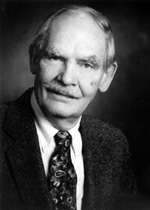 Pohl’s works often have a satirical undertone. Many of his works criticize the excesses of capitalism for instance, or are fairly cynical about the political influence and proper healthcare money can buy. Robinette is not adverse to using his wealth to get things done his way for instance. It is not quite as apparent in this book however. The most notable thing about this novel is that it is drenched in fear. The fear of meeting the unexpected in space, where there is no retreat and very little margin for error. More than a few science fiction novels feature fear, suspicion and paranoia. Especially the so called big dumb object stories, of which Gateway could be considered a variation, usually contain it in a general measure. I guess it is not as claustrophobic as Gateway, but the knowledge that aliens are near weighs on the characters. Due to the number of point of view characters, it is not as oppressive as in the previous novel, but it is almost always present in the background as each of these characters experiences their own personal flavour of fear.
Pohl’s works often have a satirical undertone. Many of his works criticize the excesses of capitalism for instance, or are fairly cynical about the political influence and proper healthcare money can buy. Robinette is not adverse to using his wealth to get things done his way for instance. It is not quite as apparent in this book however. The most notable thing about this novel is that it is drenched in fear. The fear of meeting the unexpected in space, where there is no retreat and very little margin for error. More than a few science fiction novels feature fear, suspicion and paranoia. Especially the so called big dumb object stories, of which Gateway could be considered a variation, usually contain it in a general measure. I guess it is not as claustrophobic as Gateway, but the knowledge that aliens are near weighs on the characters. Due to the number of point of view characters, it is not as oppressive as in the previous novel, but it is almost always present in the background as each of these characters experiences their own personal flavour of fear.
There is one element in this novel that I absolutely didn’t like, and that is the way Robinette’s wife is portrayed. She is practically perfect in every way, knowing what is wrong with him before he knows himself and allowing him to go after the love of his life, who according to physics should be out of reach forever. Events in Gateway are more than enough reason to feel guilty but Robinette’s treatment of his wife certainly adds to the problem. Siegfried’s work doesn’t appear to be done. The story is a bit open ended on this point. It looks like Pohl will get back to it in the third volume.
I guess you could say Pohl took a bit more conventional approach in writing Beyond the Blue Event Horizon. It makes the book less groundbreaking than Gateway was and probably is part of the reason why it didn’t win any of the awards it was nominated for. The scope of it is obviously much wider too, and the many switches in point of view makes it appear a bit less structured than its predecessor. If you view the story as the unveiling of (part of) a mystery, it makes more than enough sense to me. In the end I guess I agree with many of the critics that it is not quite as good a novel as Gateway was. I also think it would have been nice if it had been a little more self contained; if it were fantasy I’d say this book suffered from the middle book syndrome a bit. That being said, it is a good science fiction novel in the classic sense. Plenty of hard science, scientific speculation and a much larger scope than the first book in the series offer their own attractions. I guess it depends on what you want out of a novel but I thought it was an enjoyable read.
Forays into Fantasy: The Compleat Enchanter by L. Sprague de Camp and Fletcher Pratt
Scott Lazerus is a Professor of Economics at Western State College in Gunnison, Colorado, and has been a science fiction fan since the 1970s. Recently, he began branching out into fantasy, and was surprised by the diversity of the genre. It’s not all wizards, elves, and dragons! Scott’s new blog series, Forays into Fantasy, is an SF fan’s exploration of the various threads of fantastic literature that have led to the wide variety of fantasy found today. FiF will examine some of the most interesting landmark books of the past, along with a few of today’s most acclaimed fantasies, building up an understanding of the connections between fantasy’s origins, its touchstones, and its many strands of influence.
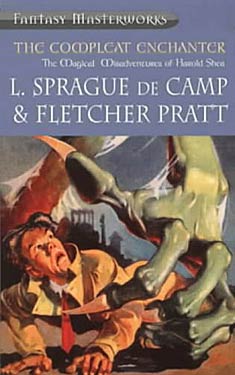 In 1939, L. Sprague de Camp, just embarking on a writing career, was introduced to Fletcher Pratt, who had published a number of stories in the science fiction pulps beginning in 1928, while working for Hugo Gernsback as a translator of European SF stories. De Camp became a regular at Pratt’s gatherings based around his elaborate naval war games. When John W. Campbell‘s Unknown fantasy magazine debuted in 1939, Pratt suggested a collaboration between the two authors–a series of novellas "about a hero who projects himself into the parallel worlds described in our world in myths and legends. We made our protagonist a brash, self-conceited young psychologist named Harold Shea," as de Camp explains in his 1975 essay "Fletcher and I."
In 1939, L. Sprague de Camp, just embarking on a writing career, was introduced to Fletcher Pratt, who had published a number of stories in the science fiction pulps beginning in 1928, while working for Hugo Gernsback as a translator of European SF stories. De Camp became a regular at Pratt’s gatherings based around his elaborate naval war games. When John W. Campbell‘s Unknown fantasy magazine debuted in 1939, Pratt suggested a collaboration between the two authors–a series of novellas "about a hero who projects himself into the parallel worlds described in our world in myths and legends. We made our protagonist a brash, self-conceited young psychologist named Harold Shea," as de Camp explains in his 1975 essay "Fletcher and I."
De Camp credits Pratt with the original idea behind the series, and considers him the "senior member" of the collaboration. They brainstormed the plots together, with Pratt providing most of the background for the stories’ mythological and literary settings. De Camp would take notes, and then write a rough draft, which Pratt would turn into a final draft. Lastly, de Camp would make the final edits prior to sending them to Campbell. The stories were a perfect fit for Unknown, where the first three novellas were published in 1940 and 1941. As John Clute and John Grant explain in The Encyclopedia of Fantasy, "Campbell sought to ensure the fantasy elements in Unknown obeyed some set of laws, in effect treating the supernatural as another science."
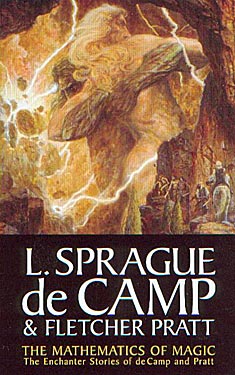 The title of the second novella, "The Mathematics of Magic" (1940), nicely encapsulates the rationalized approach to fantasy Campbell was looking for in the magazine. In each story, a mental technique developed by a group of psychologists is used to transport Shea and his companions to an alternate universe based on a national mythology or well-known literary setting. As lead psychologist Dr. Chalmers puts it, "the method consists of filling your mind with the fundamental assumptions of the world in question…. If one of these infinite other worlds–which up to now may be said to exist in a logical but not in an empirical sense–is governed by magic, you might expect to find a principle like that of dependence invalid, but principles of magic, such as the Law of Similarity, valid." Our world, in which cause and effect are linked by physical laws (dependence), is then replaced by a world where "effects resemble causes. It’s not valid for us, but primitive peoples firmly believe it. For instance, they think you can make it rain by pouring water on the ground with appropriate mumbo jumbo." By internalizing these magical laws, our heroes not only transport themselves to alternate worlds, but, once achieving a thorough enough understanding of the laws of these worlds, become practicing magicians there.
The title of the second novella, "The Mathematics of Magic" (1940), nicely encapsulates the rationalized approach to fantasy Campbell was looking for in the magazine. In each story, a mental technique developed by a group of psychologists is used to transport Shea and his companions to an alternate universe based on a national mythology or well-known literary setting. As lead psychologist Dr. Chalmers puts it, "the method consists of filling your mind with the fundamental assumptions of the world in question…. If one of these infinite other worlds–which up to now may be said to exist in a logical but not in an empirical sense–is governed by magic, you might expect to find a principle like that of dependence invalid, but principles of magic, such as the Law of Similarity, valid." Our world, in which cause and effect are linked by physical laws (dependence), is then replaced by a world where "effects resemble causes. It’s not valid for us, but primitive peoples firmly believe it. For instance, they think you can make it rain by pouring water on the ground with appropriate mumbo jumbo." By internalizing these magical laws, our heroes not only transport themselves to alternate worlds, but, once achieving a thorough enough understanding of the laws of these worlds, become practicing magicians there.
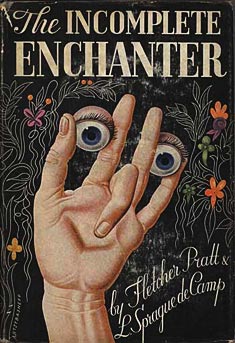 In the first novella, "The Roaring Trumpet" (1940), Shea, feeling vaguely dissatisfied with his humdrum life in Ohio and yearning for adventure, fires up the "syllogismobile" (his irreverent term for the logical formulations used for inter-universe transportation) for a trip to the world of Irish legend. But Shea has not grasped Dr. Chalmers concepts quite well enough to control the process precisely, and ends up in the wrong legend–that of Norse mythology. Shea is also unprepared for how to make use of magic in this world, but he gradually figures it out, becoming more proficient as he learns how the laws work. This partial understanding of the rules of the worlds he and his companions travel to means that the magic often doesn’t go quite right–the main source of the humor for which the series is known. In "The Mathematics of Magic", Shea and Chalmers, trying to conjure a dragon, get the qualitative aspect of the spell correct, but can’t nail down the quantitative. Instead of one dragon, they get 100; on the second attempt, they get .01 (a mini-dragon). They can’t figure out how to get the decimal point in the right place.
In the first novella, "The Roaring Trumpet" (1940), Shea, feeling vaguely dissatisfied with his humdrum life in Ohio and yearning for adventure, fires up the "syllogismobile" (his irreverent term for the logical formulations used for inter-universe transportation) for a trip to the world of Irish legend. But Shea has not grasped Dr. Chalmers concepts quite well enough to control the process precisely, and ends up in the wrong legend–that of Norse mythology. Shea is also unprepared for how to make use of magic in this world, but he gradually figures it out, becoming more proficient as he learns how the laws work. This partial understanding of the rules of the worlds he and his companions travel to means that the magic often doesn’t go quite right–the main source of the humor for which the series is known. In "The Mathematics of Magic", Shea and Chalmers, trying to conjure a dragon, get the qualitative aspect of the spell correct, but can’t nail down the quantitative. Instead of one dragon, they get 100; on the second attempt, they get .01 (a mini-dragon). They can’t figure out how to get the decimal point in the right place.
In another example, at the end of "The Roaring Trumpet," Shea comes up with a spell to get Heimdall and himself to Ragnarok on time by riding flying broomsticks, but the spell is not precise enough to include a reliable means of controlling their flight:
"Shea gripped the stick till his knuckles were white. Up – up – up he went, till everything was blotted out in the damp opaqueness of cloud. The broom rushed on at a steeper and steeper angle, till Shea found to his horror that it was rearing over backward. He wound his legs around the stick and clung, while the broom hung for a second suspended at the top of its loop with Shea dangling beneath. It dived, then fell over sidewise, spun this way and that, with its passenger flopping like a bell clapper."
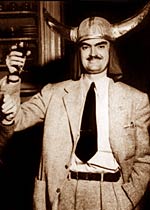 These misapplied spells, used for comedic effect, are a hallmark of the stories, and a source of the title of the book that combines the first two novellas, and by which the series itself has come to be known–The Incomplete Enchanter (1941). As for the plot, after becoming magically proficient and helping the Norse gods in the run-up to Ragnarok, Shea is sent home by a witch prior to the world-ending battle. Making better preparations this time, Shea and Chalmers, in "The Mathematics of Magic," travel to the world of Spenser’s The Faerie Queen (1596). While helping Queen Gloriana defeat a cabal of evil magicians (ending with a rather startling scene of magical massacre), Shea meets the huntress Belphebe, who will become his wife and travel with him back to Ohio at story’s end, while Chalmers stays behind, having fallen for a magical doppelganger of Lady Florimel, who he hopes to transform into a real woman once he masters enough magic.
These misapplied spells, used for comedic effect, are a hallmark of the stories, and a source of the title of the book that combines the first two novellas, and by which the series itself has come to be known–The Incomplete Enchanter (1941). As for the plot, after becoming magically proficient and helping the Norse gods in the run-up to Ragnarok, Shea is sent home by a witch prior to the world-ending battle. Making better preparations this time, Shea and Chalmers, in "The Mathematics of Magic," travel to the world of Spenser’s The Faerie Queen (1596). While helping Queen Gloriana defeat a cabal of evil magicians (ending with a rather startling scene of magical massacre), Shea meets the huntress Belphebe, who will become his wife and travel with him back to Ohio at story’s end, while Chalmers stays behind, having fallen for a magical doppelganger of Lady Florimel, who he hopes to transform into a real woman once he masters enough magic.
A third story, "The Castle of Iron," appeared in Unknown in 1941, and was later expanded into a novel published in 1950. The three stories would ultimately be collected in 1975 as The Compleat Enchanter. This time, Chalmers has transported himself from the world of The Faerie Queen to the world of its literary source–Ariosto’s Orlando Furioso (1532), based on legends of the conflict between Charlemagne’s knights and the Saracens attempting to invade Europe in the eighth century–hoping to get assistance from that world’s sorcerers in restoring Florimel to humanity. In another example of "incomplete enchantment," Chalmers, attempting to snatch Shea from Ohio in order to assist his magical studies, ends up with Belphebe instead. Now in Ariosto’s world instead of Spenser’s, Belphebe becomes Belphagor, the corresponding character in Orlando Furioso, with no memory of her previous adventures or her marriage to Shea. Confined to the eponymous castle by a powerful sorcerer, Shea and his companions must master the rules of Ariosto’s magical world in order to restore Belphebe and Florimel, while avoiding getting caught in the middle of the local conflict. Their misadventures involve, among other magical madness, infantile Paladins, a mistaken werewolf, a hippogriff and a magic carpet, culminating with a storming sorcerers’ battle.
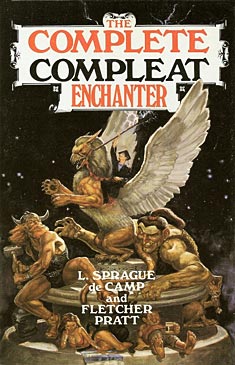 After expanding "The Castle of Iron", de Camp and Pratt went on to publish two more novellas–"The Wall of Serpents" in 1953 and "The Green Magician" in 1954. The full sequence of five eventually appeared as The Complete Compleat Enchanter. (The Fantasy Masterworks version of The Compleat Enchanter also contains all five stories. The NESFA Press collection titled The Mathematics of Magic also includes all the stories, with the addition of two more Shea stories written by de Camp in the early ‘90s.) In "The Wall of Serpents", Shea visits the world of Finnish mythology as described in the Kalevala, and finally makes it to Ireland in "The Green Magician", but the formula has become a little tiresome by that point.
After expanding "The Castle of Iron", de Camp and Pratt went on to publish two more novellas–"The Wall of Serpents" in 1953 and "The Green Magician" in 1954. The full sequence of five eventually appeared as The Complete Compleat Enchanter. (The Fantasy Masterworks version of The Compleat Enchanter also contains all five stories. The NESFA Press collection titled The Mathematics of Magic also includes all the stories, with the addition of two more Shea stories written by de Camp in the early ‘90s.) In "The Wall of Serpents", Shea visits the world of Finnish mythology as described in the Kalevala, and finally makes it to Ireland in "The Green Magician", but the formula has become a little tiresome by that point.
The basic idea is always the same–our heroes arrive in a new world where they must learn the rules of magic in order to help avert a catastrophe and find their way home. The strength of the stories is not in the plotting, but in the comedy and the excitement created by the incidents which tumble on one after another as the stories progress. The stories are also notable for their tone of near-intoxication induced in the characters and reader as a result of the pure exhilaration of their travels into the worlds of magic. (But, as with other sorts of intoxication, it can be overdone, and I was having a hard time continuing with the fourth and fifth novellas, as they began to seem repetitive. This is a series probably best experienced in smaller doses.) As in Silverlock, which also made use of Orlando Furioso as a major source (and whose author, John Myers Myers, was probably influenced by the Shea stories when writing his 1949 novel), immersion in the world of stories is a transformative and life-enhancing experience for characters who feel repressed by their mundane lives. By extension, this idea might be seen to represent the value of fantasy itself to its readers.
 Along with being a key exemplar of Unknown-style fantasy, the Incomplete Enchanter sequence also fits into a long tradition of humorous fantasy, stretching back to A Midsummer Night’s Dream and forward to Terry Pratchett. Pratt and de Camp certainly would have known the work of James Branch Cabell and Thorne Smith, published earlier in the century, which mixes mythology, fantasy, and social satire. In turn, de Camp and Pratt would influence the humorous fantasies of Piers Anthony, Robert Asprin, and many others. In the 1990s, Baen would publish two anthologies of new Harold Shea stories by modern authors influenced by the series.
Along with being a key exemplar of Unknown-style fantasy, the Incomplete Enchanter sequence also fits into a long tradition of humorous fantasy, stretching back to A Midsummer Night’s Dream and forward to Terry Pratchett. Pratt and de Camp certainly would have known the work of James Branch Cabell and Thorne Smith, published earlier in the century, which mixes mythology, fantasy, and social satire. In turn, de Camp and Pratt would influence the humorous fantasies of Piers Anthony, Robert Asprin, and many others. In the 1990s, Baen would publish two anthologies of new Harold Shea stories by modern authors influenced by the series.
A major aspect of the comedy in these stories, the inability to control magic, whether as a source of comedy or suspense, also has a long history. For example, consider Goethe’s The Sorcerer’s Apprentice (1798), which became the basis for the Mickey Mouse sequence in Disney’s Fantasia (coincidentally also released in 1940, the same year the Shea sequence began). Shea’s unending procession of dragons is reminiscent of the multiplying brooms and water pails in that story. And the idea that magical spells can be difficult to control, resulting in unintended consequences, became the starting point of nearly every plot in the hundreds of episodes of Bewitched and I Dream of Jeannie. Come to think of it, in this age of CGI, The Magical Misadventures of Harold Shea would probably work pretty well as a sitcom….
The Horror! The Horror! – Tom Piccirilli
Guest Blogger and WWEnd Member, Charles Dee Mitchell, has contributed a great many book reviews to WWEnd including his extensive Philip K. Dickathon blog series. In this series Dee explores the darker side of genre fiction and it’s practitioners. Be sure to visit his blog www.potatoweather.blogspot.com for more genre goodness.
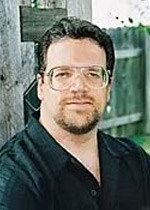 The less Tom Piccirilli encumbers his novels with plot, the better they are. At least that has been the case in his five early horror novels I have read: Hexes (1999), The Deceased (2000), The Night Class (2001), A Choir of Ill Children (2004) and, Headstone City (2006). The novels are by no means short of grotesque and often unpleasant incidents. But Piccirilli works by accumulation not by character arcs and interwoven themes. His theme is consistently that of a young man, in his late twenties or thirties, who must come to accept his role in society, whether it is the gangland of Brooklyn or a backwater town somewhere in the American South. But the novels are not traditional bildungsromans. This is not in the world of David Copperfield or Wilhelm Meister’s Apprenticeship. These are nightmares.
The less Tom Piccirilli encumbers his novels with plot, the better they are. At least that has been the case in his five early horror novels I have read: Hexes (1999), The Deceased (2000), The Night Class (2001), A Choir of Ill Children (2004) and, Headstone City (2006). The novels are by no means short of grotesque and often unpleasant incidents. But Piccirilli works by accumulation not by character arcs and interwoven themes. His theme is consistently that of a young man, in his late twenties or thirties, who must come to accept his role in society, whether it is the gangland of Brooklyn or a backwater town somewhere in the American South. But the novels are not traditional bildungsromans. This is not in the world of David Copperfield or Wilhelm Meister’s Apprenticeship. These are nightmares.
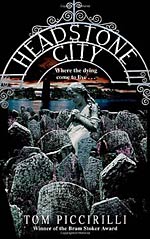 Demonic evil, ghosts, astral projections, some handy knowledge of witchcraft, and alternate realities are daily issues for Piccirilli’s protagonists. In Headstone City, Johnny Danetello endures frequent visitations from the dead, ranging from the girl he could not save from an overdose to his mother to "the boy with the damaged head." Caleb Prentiss, an alcoholic upperclassman at a small, snowbound Midwestern university, wants to find out more about the girl murdered in his dorm room over winter break. He is often accompanied by his sister who committed suicide; and, when he receives the unasked-for blessing of the stigmata in both palms, he leaves bloody paths across the snowy campus. Thomas, the central character of A Choir of Ill Children has too many issues to go into here, but one involves the care of his brothers, triplets conjoined at the frontal lobe.
Demonic evil, ghosts, astral projections, some handy knowledge of witchcraft, and alternate realities are daily issues for Piccirilli’s protagonists. In Headstone City, Johnny Danetello endures frequent visitations from the dead, ranging from the girl he could not save from an overdose to his mother to "the boy with the damaged head." Caleb Prentiss, an alcoholic upperclassman at a small, snowbound Midwestern university, wants to find out more about the girl murdered in his dorm room over winter break. He is often accompanied by his sister who committed suicide; and, when he receives the unasked-for blessing of the stigmata in both palms, he leaves bloody paths across the snowy campus. Thomas, the central character of A Choir of Ill Children has too many issues to go into here, but one involves the care of his brothers, triplets conjoined at the frontal lobe.
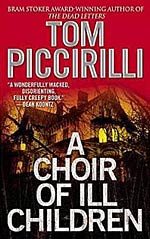 Piccirilli’s locales are sharply observed locations that could exist nowhere but in his novels. In addition to the snowbound campus in The Night Class and the swampy town of Kingdom Come in A Choir of Ill Children, Piccirilli delineates in Hexes the town of Summerfel – Summerfell! – a small town dominated by an asylum named Panecraft, a lighthouse undermined by tunnels containing some unspeakable horror, a local hangout called Krunch Burger, and a rich man’s house that is more like a castle than a mansion. If you don’t like things in Summerfel, you can always move the next town over to Gallows. Headstone City takes place in an imaginary neighborhood of an otherwise identifiable Brooklyn, a neighborhood where the decaying mansions of stars from the earliest days of silent film surround the enormous cemetery of the title. The neighborhood is still run by some goonish gangsters who have mostly moved their money into legit businesses but who still, guided by a misplaced enthusiasm for their once glorious past, enact the occasional bloody vendetta against one another.
Piccirilli’s locales are sharply observed locations that could exist nowhere but in his novels. In addition to the snowbound campus in The Night Class and the swampy town of Kingdom Come in A Choir of Ill Children, Piccirilli delineates in Hexes the town of Summerfel – Summerfell! – a small town dominated by an asylum named Panecraft, a lighthouse undermined by tunnels containing some unspeakable horror, a local hangout called Krunch Burger, and a rich man’s house that is more like a castle than a mansion. If you don’t like things in Summerfel, you can always move the next town over to Gallows. Headstone City takes place in an imaginary neighborhood of an otherwise identifiable Brooklyn, a neighborhood where the decaying mansions of stars from the earliest days of silent film surround the enormous cemetery of the title. The neighborhood is still run by some goonish gangsters who have mostly moved their money into legit businesses but who still, guided by a misplaced enthusiasm for their once glorious past, enact the occasional bloody vendetta against one another.
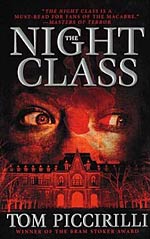 Several internet customer reviews complain that these books make no sense, but I think those readers are looking for the wrong things. Like a coherent plot. Piccirilli is a lot of fun to read. There is always that central character who knows a bit more than those around him; whether it is more effective magical spells or just that so much of what is going on is bullshit. When Piccirilli brings more plotting into the mix, things tend to go wrong. The Deceased turns into little more that a pretty good horror movie, with girls, who I assume have large breasts, running around an old house during a thunderstorm. The gangster story that runs through Headstone City is not as resolved or effective as the weirdness that underlies it.
Several internet customer reviews complain that these books make no sense, but I think those readers are looking for the wrong things. Like a coherent plot. Piccirilli is a lot of fun to read. There is always that central character who knows a bit more than those around him; whether it is more effective magical spells or just that so much of what is going on is bullshit. When Piccirilli brings more plotting into the mix, things tend to go wrong. The Deceased turns into little more that a pretty good horror movie, with girls, who I assume have large breasts, running around an old house during a thunderstorm. The gangster story that runs through Headstone City is not as resolved or effective as the weirdness that underlies it.
But these books are just the kind of fun I hoped modern horror novels could offer. They are literate, amusing, at times really icky, and never slow down. I understand that Piccirilli’s recent novels are more straightforward crime stories, so I hope he has worked out those plotting issues. On the off chance that anyone reading this might actually pick up a Piccirilli novel, I recommend starting with the best, A Choir of Ill Children. If nothing else, you will learn a really interesting new use of the word "vinegar."
WWEnd Grand Master Reading Challenge: June Review Poll
 June was another great month for the GMRC! We featured 7 reviews in the blog with 2 first time reviewers in the list. Check out these great reviews and cast your vote for the best.
June was another great month for the GMRC! We featured 7 reviews in the blog with 2 first time reviewers in the list. Check out these great reviews and cast your vote for the best.
- Shadrach in the Furnace by Robert Silverberg – (Bookkeeper)
- The Martian Chronicles by Ray Bradbury – (triseult)
- Gateway by Frederik Pohl – (jfrantz)
- The Demolished Man by Alfred Bester – (RhondaK101)
- Lavinia by Ursula K. Le Guin – (galleyangel)
- Deathbird Stories by Harlan Ellison – (Emil)
- The Stochastic Man by Robert Silverberg – (CharlesDee)
You don’t have to be a GMRC participant to vote so jump in and make your opinion count! The poll is open until July 15th so you have plenty of time to read all the reviews.
RhondaK101 has provided the updated stats.
Authors with the most books read:
- Isaac Asimov (33)
- Robert A. Heinlein (33)
- Arthur C. Clarke (31)
- Joe Haldeman (26)
Authors with the most different titles read:
- Isaac Asimov (14)
- Robert A. Heinlein (13)
- Arthur C. Clarke (11)
Books most frequently read:
- Joe Haldeman, The Forever War (13)
- Alfred Bester, The Stars My Destination (11)
- Frederik Pohl, Gateway (9)
- Ursula K. Le Guin, The Dispossessed (8)
- Ray Bradbury, Fahrenheit 451 (8)
- Arthur C. Clarke, Childhood’s End (8)
- Alfred Bester, The Demolished Man (8)
Winner gets the following:
- GMRC T-shirt – your choice of colors so long as it’s black
- GMRC button – you can never have too much flair
- Set of WWEnd Hugo Award bookmarks – I’ll be honest, we over-bought these for WorldCon so we need to unload some but they’re still pretty cool and they will, in fact, hold your place in any paper book.
- Book of your choice from the WWEnd bookshelf – the winner will get a list of a dozen titles to pick from
- Everlasting Glory – So you’ll have that goin’ for ya. Which is nice.
Runners up will get a GMRC button and a set of bookmarks.



















 Full Details
Full Details
